
DANIELLE STEIN FAIRHURST is the Principal of Plum Solutions, a Sydney-based consultancy specialising in financial modelling and analysis. With many years' experience as a financial analyst, she helps her clients create meaningful financial models. She has hands-on experience in a number of industry sectors, including telecommunications, information systems, manufacturing, and financial services. Stein Fairhurst is regularly engaged as a speaker, course facilitator, financial modelling consultant, and analyst around the world, and has taught management accounting subjects at Sydney University.
Preface xi
CHAPTER 1 What Is Financial Modelling? 1
What’s the Difference between a Spreadsheet and a Financial Model? 3
Types and Purposes of Financial Models 4
Tool Selection 5
What Skills Do You Need to Be a Good Financial Modeller? 10
The Ideal Financial Modeller 16
Summary 19
CHAPTER 2 Building a Model 21
Model Design 21
The Golden Rules for Model Design 22
Design Issues 24
The Workbook Anatomy of a Model 25
Project Planning Your Model 27
Model Layout Flow Charting 28
Steps to Building a Model 28
Information Requests 35
Version-Control Documentation 36
Summary 37
CHAPTER 3 Best Practice Principles of Modelling 39
Document Your Assumptions 39
Linking, Not Hard Coding 39
Only Enter Data Once 40
Avoid Bad Habits 41
Use Consistent Formulas 41
Format and Label Clearly 41
Methods and Tools of Assumptions Documentation 42
Linked Dynamic Text Assumptions Documentation 48
What Makes a Good Model? 51
Summary 52
CHAPTER 4 Financial Modelling Techniques 53
The Problem with Excel 53
Error Avoidance Strategies 54
How Long Should a Formula Be? 59
Linking to External Files 61
Building Error Checks 63
Avoid Error Displays in Formulas 66
Circular References 67
Summary 70
CHAPTER 5 Using Excel in Financial Modelling 71
Formulas and Functions in Excel 71
Excel Versions 73
Handy Excel Shortcuts 74
Basic Excel Functions 76
Logical Functions 82
Nesting: Combining Simple Functions to Create Complex Formulas 84
Cell Referencing Best Practices 86
Named Ranges 89
Summary 92
CHAPTER 6 Functions for Financial Modelling 93
Aggregation Functions 93
LOOKUP Formulas 100
Other Useful Functions 106
Working with Dates 115
Financial Project Evaluation Functions 121
Loan Calculations 126
Summary 131
CHAPTER 7 Tools for Model Display 133
Basic Formatting 133
Custom Formatting 133
Conditional Formatting 139
Sparklines 143
Bulletproofing Your Model 147
Customising the Display Settings 151
Form Controls 157
Summary 171
CHAPTER 8 Tools for Financial Modelling 173
Hiding Sections of a Model 173
Grouping 178
Array Formulas 179
Goal Seeking 184
Pivot Tables 186
Macros 190
User-Defined Functions (UDFs) 198
Summary 200
CHAPTER 9 Common Uses of Tools in Financial Modelling 201
Escalation Methods for Modelling 201
Understanding Nominal and Effective (Real) Rates 206
Calculating Cumulative Totals 209
How to Calculate a Payback Period 210
Weighted Average Cost of Capital (WACC) 214
Building a Tiering Table 216
Modelling Depreciation Methods 219
Break-Even Analysis 227
Summary 233
CHAPTER 10 Model Review 235
Rebuilding an Inherited Model 235
Auditing a Financial Model 245
Appendix 10.1: QA Log 250
Summary 250
CHAPTER 11 Stress-Testing, Scenarios, and Sensitivity Analysis in Financial Modelling 251
What’s the Difference between Scenario, Sensitivity, and What-If Analysis? 252
Overview of Scenario Analysis Tools and Methods 253
Advanced Conditional Formatting 261
Comparing Scenario Methods 264
Summary 273
CHAPTER 12 Presenting Model Output 275
Preparing an Oral Presentation for Model Results 275
Preparing a Graphic or Written Presentation for Model Results 276
Chart Types 279
Working with Charts 291
Handy Charting Hints 295
Dynamic Range Names 297
Charting with Two Different Axes and Chart Types 300
Bubble Charts 302
Waterfall Charts 307
Summary 316
About the Author 317
About the Website 319
Index 321
The New copy of this book will include any supplemental materials advertised. Please check the title of the book to determine if it should include any access cards, study guides, lab manuals, CDs, etc.
The Used, Rental and eBook copies of this book are not guaranteed to include any supplemental materials. Typically, only the book itself is included. This is true even if the title states it includes any access cards, study guides, lab manuals, CDs, etc.